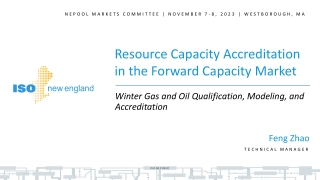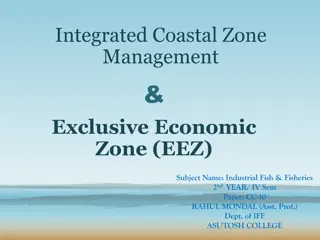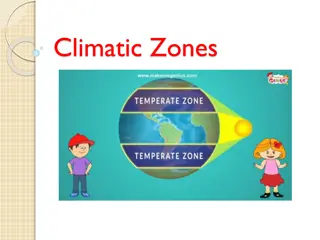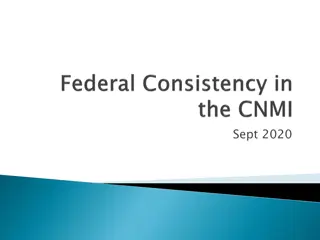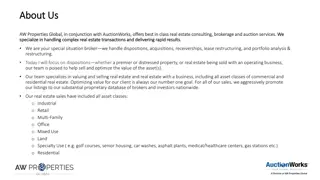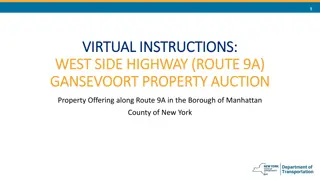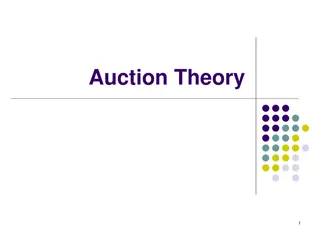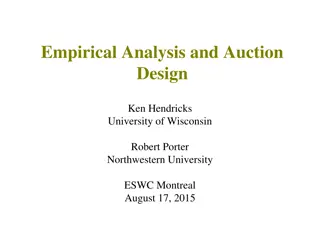Capacity Zone Modeling for Forward Capacity Auction 17 Results
This presentation unveils the Capacity Zone modeling calculations for Forward Capacity Auction 17 associated with the 2026-2027 Capacity Commitment Period by ISO-NE PUBLIC. It delves into boundary definitions, import-constrained zone modeling, and market rules guiding the assessments and modeling procedures.
Download Presentation

Please find below an Image/Link to download the presentation.
The content on the website is provided AS IS for your information and personal use only. It may not be sold, licensed, or shared on other websites without obtaining consent from the author.If you encounter any issues during the download, it is possible that the publisher has removed the file from their server.
You are allowed to download the files provided on this website for personal or commercial use, subject to the condition that they are used lawfully. All files are the property of their respective owners.
The content on the website is provided AS IS for your information and personal use only. It may not be sold, licensed, or shared on other websites without obtaining consent from the author.
E N D
Presentation Transcript
J U N E 2 9 , 2 0 2 2 | N E P O O L P O W E R S U P P L Y P L A N N I N G C O M M I T T E E | H O L Y O K E , M A Zonal Modeling For FCA 17 Alan McBride D I R E C T O R , T R A N S M I S S I O N S E R V I C E S A N D R E S O U R C E Q U A L I F I C A T I O N ISO-NE PUBLIC
Summary This presentation provides the results of the Capacity Zone modeling calculations for Forward Capacity Auction (FCA) 17, which is associated with the 2026-2027 Capacity Commitment Period ISO-NE PUBLIC 2
Capacity Zone Boundary Definitions: Objective Criteria Testing for FCA 17 The following boundaries were evaluated using the import- constrained zonal modeling objective criteria Connecticut import Southeast New England (SENE) import Consists of the Northeast Massachusetts (including Boston), Southeast Massachusetts and Rhode Island Load Zones The following boundaries were evaluated using the export- constrained zonal modeling objective criteria Northern New England (NNE) export Consists of the Vermont, New Hampshire and Maine Load Zones Maine Export Consists of the Maine Load Zone, which is nested within the NNE The remaining Load Zone (Western Central Massachusetts) was not evaluated using the zonal modeling objective criteria It will be merged into the Rest-of-Pool (ROP) Capacity Zone, along with the NY-AC ties and Phase II ISO-NE PUBLIC 3
IMPORT CONSTRAINED ZONE MODELING CALCULATIONS ISO-NE PUBLIC ISO-NE PUBLIC 4
Market Rule 1, Section III.12.4(b) The ISO shall model in the Forward Capacity Auction, as separate import- constrained Capacity Zones, those zones identified in the most recent annual assessment of transmission transfer capability pursuant to ISO Tariff Section II, Attachment K, for which the second contingency transmission capability results in a line-line Transmission Security Analysis (TSA) requirement, calculated pursuant to Section III.12.2.1.2 and pursuant to ISO New England Planning Procedures, that is greater than the Existing Qualified Capacity in the zone, with the largest generating station in the zone modeled as out-of-service Each assessment will model out-of-service all Retirement De-List Bids and Permanent De-List Bids (including any received for the current Forward Capacity Auction at the time of this calculation), substitution auction demand bids submitted for the current Forward Capacity Auction, rejected for reliability Static De-List Bids from the most recent previous Forward Capacity Auction, and rejected for reliability Dynamic De-List Bids from the most recent previous Forward Capacity Auction ISO-NE PUBLIC 5
Objective Criteria Testing of Connecticut as an Import-Constrained Capacity Zone Line-Line TSA Values (Milestone 2&3 Out-of-Service) MW FCA 17 TSA Requirement for Connecticut 7,388 1,200 8,588 8,159 -647 3,400 10,912 2022 forecast Sub-area 90/10 Load (excluding BTM PV forecast) Reserves (Loss of import capability: line-line calculation) Sub-area Transmission Security Need Existing Resources1 (not including Millstone Station) Assumed Unavailable Capacity (see below) Sub-area N-1 Import Limit Sub-area Available Resources 5,635 TSA "Requirement" with Millstone Station out-of-service* 2022 Derating Factors (%) 2026-2027 MW Amounts (Existing Capacity - Before Derating) Existing Capacity Details 7,141 119 205 694 Regular Generation1 (not including Millstone Station) redacted 0 Intermittent 12 0 Active Demand Capacity Resources (ADCR) Passive DR 1. Derating factors are redacted because they would reveal the derating factor of a specific resource TSA Requirement (5,635 MW) < Existing Capacity (8,159 MW) with Millstone Station out-of-service. Therefore, Connecticut will not be modeled as an import-constrained Capacity Zone and will be merged into the ROP Capacity Zone for FCA 17. *Note that this is not the actual TSA calculation for the Connecticut Zone. The above calculation is only relevant for the Capacity Zone formation objective criteria calculation. ISO-NE PUBLIC 6
Objective Criteria Testing of SENE as an Import- Constrained Capacity Zone Line-Line TSA Values (MW) (Canal Station Out-of-Service)1 FCA 17 TSA Requirement for SENE 12,163 400 12,563 8,362 -338 5,250 13,275 2022 Sub-area forecast 90/10 Load (excluding BTM PV forecast) Reserves (Loss of import capability: line-line calculation) Sub-area Transmission Security Need Existing Resources (not including Canal station) Assumed Unavailable Capacity (see below) Sub-area N-1 Import Limit Sub-area Available Resources 7,621 TSA "Requirement" with Canal Station out-of-service* 2022 Derating Factors (%)2 2026-2027 MW Amounts (Existing Capacity - Before Derating) Existing Capacity Details 6,607 461 127 67 77 1,024 Regular Generation 2 (not including Canal Station) redacted 0 Intermittent NEMA ADCR 21.4 RI ADCR 23.7 SEMA ADCR 13.5 Passive DR 0 1. Canal Station (Units 1, 2 & 3) is the next largest station in SENE 2. Derating factors are redacted because they would reveal the derating factor of a specific resource TSA Requirement (7,621 MW) < Existing Capacity (8,362 MW) with Canal Station out-of-service. Therefore, SENE will not be modeled as a separate import-constrained zone for FCA 17 and will be merged into the ROP Capacity Zone. *Note that this is not the actual TSA calculation for SENE. The above calculation is only relevant for the Capacity Zone formation objective criteria calculation. ISO-NE PUBLIC 7
Import-Constrained Zones - Conclusions The Connecticut zone has more Existing Qualified Capacity than the line-line TSA with the largest station out of service The Connecticut zone will not be modeled as an import-constrained Capacity Zone for FCA 17 This zone will be merged into the ROP Capacity Zone for FCA 17 The SENE zone has more Existing Qualified Capacity than the line-line TSA with the largest station out of service The SENE zone will not be modeled as an import-constrained Capacity Zone for FCA 17 This zone will be merged into the ROP Capacity Zone for FCA 17 ISO-NE PUBLIC 8
EXPORT CONSTRAINED ZONE CALCULATIONS ISO-NE PUBLIC ISO-NE PUBLIC 9
Market Rule 1, Section III.12.4(a) The ISO shall model in the Forward Capacity Auction, as separate export-constrained Capacity Zones, those zones identified in the most recent annual assessment of transmission transfer capability pursuant to ISO Tariff Section II, Attachment K, for which the Maximum Capacity Limit is less than the sum of the Existing Qualified Capacity and proposed new capacity that could qualify to be procured in the export constrained Capacity Zone, including existing and proposed new Import Capacity Resources on the export-constrained side of the interface ISO-NE PUBLIC 10
Objective Criteria Testing of NNE as an Export- Constrained Capacity Zone NNE MW FCA 16 Maximum Capacity Limit1 8,555 FCA 17 NNE MW Existing Qualified Capacity 8,308 Proposed new capacity that could qualify Redacted Available import capability for new imports from New Brunswick and Highgate (after accounting for FCA 16 tie benefits) 2802 Total sum of the Existing Qualified Capacity and proposed new capacity that could qualify > 8,555 1. 2. The MCL calculation for FCA 17 will be presented at an upcoming PSPC meeting. Using the FCA 16 Values [capacity import transfer capability tie benefits existing imports]: New Brunswick [700 478 0] + Highgate [200 142 0]. ISO-NE PUBLIC 11
Objective Criteria Testing of Maine as an Export-Constrained Capacity Zone Maine MW FCA 16 Maximum Capacity Limit1 4,095 FCA 17 Maine MW Existing Qualified Capacity 3,642 Proposed new capacity that could qualify Redacted Available import capability for new imports from New Brunswick (after accounting for FCA 16 tie benefits) 2222 Total sum of the Existing Qualified Capacity and proposed new capacity that could qualify > 4,095 1. 2. The MCL calculation for FCA 17 will be presented at an upcoming PSPC meeting. Using the FCA 16 Values [capacity import transfer capability tie benefits existing imports]: New Brunswick [700 478 0]. ISO-NE PUBLIC 12
Export-Constrained Zones - Conclusions The indicative MCL for the NNE zone is less than the sum of the Existing Qualified Capacity and the proposed new capacity that could qualify for FCA 17 NNE will be modeled as an export-constrained Capacity Zone for FCA 17 The indicative MCL for the Maine zone is less than the sum of the Existing Qualified Capacity and the proposed new capacity that could qualify for FCA 17 Maine will be modeled as an export-constrained Capacity Zone for FCA 17 This Capacity Zone will be nested within the NNE Capacity Zone ISO-NE PUBLIC 13
Capacity Zones to be Modeled in FCA 17 Note: Supply from New Brunswick is modeled as connected to Maine Maine NNE Rest-of-Pool (SENE [NEMA/Boston and SEMA/RI], West Central Mass, Connecticut, NY-AC & Phase II) ISO-NE PUBLIC 14
Next Steps Review the MCLs associated with the NNE and Maine Capacity Zones with the PSPC in August ISO-NE PUBLIC 15



